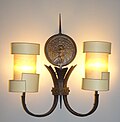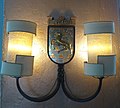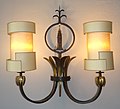Guild for metal and plastics technology Berlin
| Guild for metal and plastics technology Berlin (metal guild ) |
|
|---|---|
|
|
|
| legal form | Professional body |
| purpose | Interest group |
| Seat |
|
| founding | 1578
|
| place | Berlin |
| Board | Obermeister Erwin Kostyra |
| executive Director | Detlef Pohl |
| Members | 220 |
| Organization type | National guild |
| Website | www.metallinnung.de |
The guild for metal and plastic technology Berlin (metal guild ) is a corporation under public law . It represents the interests of more than 200 members. The guild works in accordance with Section 54 of the Crafts Code and is under the supervision of the Berlin Chamber of Crafts . Membership in the metal guild is voluntary.
tasks
The metal guild represents the economic and technical interests of its members vis-à-vis the public, politics and authorities. Their tasks include in particular
- to promote the common commercial interests of its members
- to cultivate the common spirit and professional honor
- to strive for a good relationship between masters, journeymen and apprentices
- to regulate and monitor apprenticeship training in accordance with the regulations of the Chamber of Crafts and to ensure the professional training of the apprentices and to promote their personal development
- to hold the journeyman's examinations and to set up journeyman's examination committees for this purpose, provided that it is authorized to do so by the Chamber of Crafts
- to promote the craftsmanship of the masters and journeymen, for this purpose technical schools were set up and conduct courses
- to participate in the administration of the vocational schools in accordance with the federal and state regulations
- to promote the cooperative system in the craft sector
- to provide the authorities with expert opinions and information on matters relating to the trades represented in it (standardization work)
- to support the other craft organizations and institutions in fulfilling their tasks
- to carry out the regulations and orders issued by the Chamber of Crafts within its jurisdiction.
Here the metal guild
- Establish and promote facilities to improve working methods and management in order to increase the profitability of their members' businesses
- advise the awarding authorities on the award of public deliveries and services
- support the manual press system (public relations)
The metal guild can
- Conclude collective agreements insofar as and as long as such contracts are not concluded by the guild association for the area of the craft guild,
- set up support funds for their members and their relatives in cases of illness, death, incapacity for work or other need,
- mediate disputes between guild members and their clients upon request.
- Take measures to promote the common commercial interests of the guild members.
Memberships
- Landesinungsverband Metall Berlin-Brandenburg as a corporation under private law according to the craft regulations .
- Federal Metal Association, Essen
- Business Associations Berlin Brandenburg (UVB)
- Schutzgemeinschaft Berlin eV - Cooperation with the Berlin State Criminal Police Office for burglary prevention
- Interest group - if craft then guild (WHdI)
structure
The metal guild is led by the board and the guild manager. The board is elected every five years by the delegates of the guild assembly. Since 1999 the head master Erwin Kostyra has been at the helm. It has the guild office, the members are organized in the professional groups of metal workers, precision mechanics, metal and bell foundries, metal formers and engravers. There is also an arbitration board that can be called in in the event of disagreements between guild companies and consumers.
The Berlin guild for metal and plastics technology runs a vocational school . In the rooms, trainees ( apprentices ) are prepared for the journeyman's examination in accordance with Section 31 of the Crafts Code, this also applies to the final examination . The training of journeyman / skilled workers also takes place here, e.g. to the welder . But also the preparatory courses for the major certificate of proficiency and the master's examination are carried out by the Dr.-Louis-Schnur-Schule, in the metal guild.
Welding training workshop here with TIG
Entrance area, as a masterpiece
Award
- The metal guild awards a badge of honor in the stages of bronze, silver and gold, which is presented with a certificate.
- The badge of honor is awarded by the head master for special merits in metalworking and can be worn in the buttonhole column on the private suit as a sign of general recognition.
- The badge of honor is alloyed in the colors of the graduation and it has a diameter of 20 mm. On the front is the Berlin heraldic animal, embossed with the guild symbol of the locksmith, which rests on a circular laurel wreath.
history
- Locksmith: Auto, construction, gun and machine locksmiths,
- Blacksmiths: copper, gold, silver, hoof, weapons, nails, compasses, knives, blacksmiths and fine blacksmiths
- Casters, file cutters, needlers, winch makers, spurs, large and small watchmakers
are and were guild members.
Berlin iron pictures - art blacksmiths
Berliner Eisenbilder - locksmith's shop
Berliner Eisenbilder - toolmaking
Berliner Eisenbilder - turning shop
Berliner Eisenbilder - mechanical engineering
The history of the metalworker's guild in today's capital began in 1237 with the emergence of the cities of Berlin and Kölln . The great city fires in the 14th and 15th centuries destroyed documents and certificates in order to meet the obligation to provide evidence. But in 1280 there were the Viergewerke in Berlin, the bakers, butchers, shoemakers and drapers. They were granted a modest stake in the city regiment. The third estate were the citizens and craftsmen , including locksmiths . The locksmith's guild was officially named in 1578, together with the sporer, rifle, watch and winch makers. The councils of Berlin and Kölln have the masters of the above-mentioned trades, who are united in a laudable order, guild and brotherhood. The articles submitted by them have been checked, carefully considered and improved, and these articles, as they are in accordance with honesty and good police, confirmed and confirmed. The guilds of that time had the aim and purpose of restricting and regulating competition, privileging their own trade, the exercise of which was reserved for the guild members. In 1632 the tax code determined what the Berlin-Kölln master locksmith may charge his customers. All trades organized in a guild were treated here. Berlin, as the residence of the soldier king, had become a beautiful city in the opinion of travelers. The guild constitution was fundamentally changed, in 1731 at the endeavor of Friedrich Wilhelm I, the uniform imperial trade law was introduced. On August 6, 1732, this regulation came into force in the Prussian states and the time of independent powers was over. Here the guilds were incorporated into the new state trade law. Until 1735, a state commission for all guild trades had drawn up "general privileges" according to the new principles and uniform scheme; they were valid for the entire Kurmark. In 1734 the Berlin locksmith guild received general privilege.
The trade regulations with general trade tax , introduced in 1810 , put down the guild barriers and introduced freedom of trade. This was to lay the foundations for the reconstruction of the Prussian state . The guilds were retained, only the establishment of the trade tax was made dependent on exercising a fabric.
With the formation of Greater Berlin in 1925, the Berlin, Charlottenburg, Spandauer and Cöpenicker locksmith guilds were converted into a compulsory guild. After surviving the global economic crisis , the municipal library director formulated the pious wish in the festschrift of the German locksmith's trade in 1932: nevertheless, despite all resistance, we want to strive to preserve our locksmith's trade and to lead times towards which we again justified to say that the craft was golden has ... 1933 was the dissolution of all existing guilds and merging into a compulsory guild Greater Berlin with a total of 4,500 members despite the division of the total Berlin magistrate in 1948 and the introduction of a separate currency in the western sector, were against all odds until the mid-fifties Common ground cultivated. The possibility of a joint training existed until 1961. The last meeting of guild officials of both parts of the city took place in October 1960 and the 63rd general meeting of the metalworking and mechanical engineering trade throughout Germany took place in June 1961 in Berlin.
| Work samples of the apprentices in the district groups up to 1961 | ||||||
|---|---|---|---|---|---|---|
| Steglitz | Treptow | Zoo | Schöneberg | Friedrichshain | Kreuzberg | Neukölln |
East Berlin
The work of the guild took place in the purchasing and delivery cooperatives (ELG) from the 1960s onwards. Due to numerous external restrictions, the cohesion was unusually strong. Despite considerable pressure from the state, there was hardly any establishment of production cooperatives for the handicrafts (PGH) among locksmiths in East Berlin .
West Berlin
In October 1971 the guild became the guild for metal and plastics technology in Berlin. At the end of the eighties, the previously independent blacksmiths' guild in West Berlin joined the metal guild.
1991
With the enactment of the "Ordinance on the Organization of the Crafts in the GDR " in February, it is again possible to form guilds and to join together to form district and GDR associations, whereupon the Guild of Metal Crafts was founded in East Berlin in 1990 . As early as 1990 it became clear that all that was needed in Berlin was a united metal guild and since 1991 there has been a metal guild.
The guild motto applies today as it did then, cat's head? Piece of it!
Web links
Individual evidence
- Chronicle 425 years of locksmithing in Berlin -Fata Morgana Verlag Berlin - 2003
- Metal from VEB Verlag Technik-Berlin, license 201-370 / 149/84 - 1982
- Blacksmith's trade from Alfred Meßner Verlag Berlin - 1937
- Festschrift for the 45th Reich Association Day of the German Locksmithing Trade - 1932





















